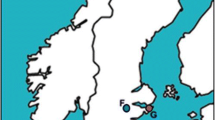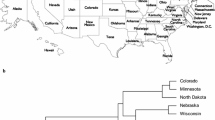Abstract
Downy mildew caused by Peronospora sparsa (syn. P. rubi) is a serious threat to commercial cultivation of arctic bramble (Rubus arcticus subsp. arcticus) in Finland. P. sparsa is distributed throughout the country in cultivated and wild arctic bramble and in cloudberry (R. chamaemorus). A total of 36 isolates of P. sparsa collected from these hosts was analysed for amplified fragment length polymorphism (AFLP). Of the 226 markers scored, 223 were polymorphic and all isolates of P. sparsa had unique AFLP fingerprints, which indicated high levels of genetic variability. An UPGMA clustering analysis of the isolates did not reveal any genetically distinguishable strains. The isolates were grouped neither according to the geographic origin nor the host from which they were isolated. Isolates of P. sparsa obtained from wild arctic bramble and one from cloudberry readily infected the leaves of the cultivated arctic bramble (cultivar ‘Pima’). Also, P. sparsa isolated from cultivated arctic bramble infected the leaves of wild arctic bramble. These data suggest that P. sparsa may be disseminated from wild arctic bramble and cloudberry to cultivated arctic bramble in the field.
Similar content being viewed by others
References
Breese WA, Shattock RC, Williamson B and Hackett C (1994) In vitro spore germination and infection of cultivars of Rubus and Rosa by downy mildews from both hosts. Annals of Applied Biology 125: 73–85
Brurberg MB, Hannukkala A and Hermansen A (1999) Genetic variability of Phytophthora infestans in Norway and Finland as revealed by mating type and fingerprint probe RG57. Mycological Research 103: 1609–1615
Burdon JJ and Silk J (1997) Sources and patterns of diversity in plant-pathogenic fungi. Phytopathology 87: 664–669
DeScenzo RA, Engel SR, Gomez G, Jackson EL, Munkvold GP, Weller J and Irelan NA (1999) Genetic analysis of Eutypa strains from California supports the presence of two pathogenic species. Phytopathology 89: 884–893
Francis SM and Waterhouse GM (1988) List of Peronosporaceae reported from the British Isles. Transactions of the British Mycological Society 91: 1–62
Fry WE, Goodwin SB, Matuszak JM, Spielman LJ and Milgroom MG (1992) Population genetics and intercontinental migrations of Phytophthora infestans. Annual Review of Phytopathology 30: 107–129
Gonzáles M, Rodríguez R, Zavala ME, Jacobo JL, Hernández F, Acosta J, Martínez O and Simpson J (1998) Characterization of Mexican isolates of Colletotrichum lindemuthianum by using differential cultivars and molecular markers. Phytopathology 88: 292–299
Goodwin SB, Sujkowski LS, Dyer AT, Fry BA and Fry WE (1995a) Direct detection of gene flow and probable sexual reproduction of Phytophthora infestans in northern North America. Phytopathology 85: 473–479
Goodwin SB, Sujkowski LS and Fry WE (1995b) Rapid evolution of pathogenicity within clonal lineages of the potato late blight disease fungus. Phytopathology 85: 669–676
Hall G (1989) Peronospora rubi CMI descriptions of pathogenic fungi and bacteria no. 976. Mycopathologia 106: 195–197
Hall HK and Shaw CG (1982) Oospores of Peronospora sparsa Berk. on Rubus species. New Zealand Journal of Experimental Agriculture 10: 429–432
Hall HK and Shaw CG (1987) Brambles: downy mildew on wild and cultivated Rubus species in New Zealand. New Zealand Journal of Experimental Agriculture 15: 57–60
Hansen M, Kraft T, Christiansson MR and Nilsson N-O (1999) Evaluation of AFLP in Beta. Theoretical and Applied Genetics 98: 845–852
Hultèn E (1971) The circumpolar plants II. Dicotyledons. Kungliga Svenska Vetenskapliga Akademins Handlingar no. 4, Serie 13: 164–165, 373–375
Koh YJ, Goodwin SB, Dyer AT, Cohen BA, Ogoshi A, Sato N and Fry WE (1994) Migrations and displacements of Phytophthora infestans populations in east Asian countries. Phytopathology 84: 922–927
Kokko H, Virtaharju O, Kärenlampi S, Cooke DEL, Williams NA and Williamson B (1999) Downy mildew (Peronsopora rubi) in Rubus arcticus: a threat to commercial berry production in Finland. Acta Horticulturae 505: 137–141
Koponen H and Valkonen J (1996) Lehtihome mesimarjan viljelyn ongelmana. Kasvinsuojelulehti 29: 39–41 (in Finnish)
Koponen H, Parikka P, Lindqvist H and Valkonen J (1998) Apua mesimarjan lehtihomeen torjuntaan. Puutarha & Kauppa, no. 47, p 15 (in Finnish)
Koponen H, Hellqvist S, Lindqvist-Kreuze H, Bång U and Valkonen JPT (2000) Occurrence of Peronospora sparsa (P. rubi) on cultivated and wild Rubus species in Finland and Sweden. Annals of Applied Biology 137: 107–112
Larsson EGK (1968) Experimental taxonomy as a base for breeding in northern Rubi. Hereditas 63: 283–351
Lindqvist H, Koponen H and Valkonen JPT (1998) Peronospora sparsa on cultivated Rubus arcticus and its detection by PCR based on ITS sequences. Plant Disease 82: 1304–1311
McKeown B (1988) Downy mildew of boysenberry and Tummelberry in the UK. Plant Pathology 37: 281–284
Michelmore RW, Ilott T, Hulbert SH and Farrara B (1988) The downy mildews. In: Ingram DS and Williams PH (eds) Advances in Plant Pathology (pp 53–76) Academic Press, London
O'Neill NR, vanBerkum P, Lin J-J, Kuo J, Ude GN, Kenworthy W and Saunders JA (1997) Application of amplified restriction fragment length polymorphism for genetic characterization of Colletotrichum pathogens of alfalfa. Phytopathology 87: 745–750
Parikka P (1996) Mesimarjan lehtihome jälleen ongelmana. Puutarha, no. 10, pp 514–515 (in Finnish)
Peever TL, Canihos Y, Olsen L, Ibañez Y-CL and Timmer W (1999) Population genetic structure and host specificity of Alternaria spp. causing brown spot of minneola tangelo and rough lemon in Florida. Phytopathology 89: 851–860
Pirinen H, Dalman P, Kärenlampi S, Tammisola J and Kokko H (1998) Description of three new arctic bramble cultivars and proposal for cultivar identification. Agricultural and Food Science in Finland 7: 455–468
Rehmany AP, Lynn JR, Tör M, Holub EB and Beynon JL (2000) A comparison of Peronospora parasitica (downy mildew) isolates from Arabidopsis thaliana and Brassica oleracea using amplified fragment length polymorphism and internal transcribed spacer 1 sequence analysis. Fungal Genetics and Biology 30: 95–103
Rosendahl S and Taylor JW (1997) Development of multiple genetic markers for studies of genetic variation in arbuscular mycorrhizal fungi using AFLP. Molecular Ecology 6: 821–829
Ryynänen A (1973) Rubus arcticus L and its cultivation. Annales Agriculturae Fenniae 12: 1–76
Ryynänen A and Dalman P (1983)A new variety of arctic bramble ‘Pima’. Annales Agriculturae Fenniae 22: 1–7
Sujkowski LS, Goodwin SB, Dyer AT and Fry WE (1994) Increased genotypic diversity via migration and possible occurrence of sexual reproduction of Phytophthora infestans in Poland. Phytopathology 84: 210–207
Tredway LP, White JF Jr, Gaut BS, Reddy PV, Richardson MD and Clarke BB (1999) Phylogenetic relationships within and between Epichloë and Neophodium endophytes as estimated by AFLP markers and rDNA-sequences. Mycological Research 103: 1593–1603
Williamson B, Breese WA and Shattock RC (1995) A histological study of downy mildew (Peronospora rubi) infection of leaves, flowers and developing fruits of Tummelberry and other Rubus spp. Mycological Research 99: 1311–1316
Vos P, Hogers R, Bleeker M, Reijans M, van der Lee T, Hornes M, Frijters A, Pot J, Peleman J, Kuiper M and Zabeau M (1995) AFLP: a new technique for DNA fingerprinting. Nucleic Acids Research 21: 4407–4414
Author information
Authors and Affiliations
Corresponding author
Rights and permissions
About this article
Cite this article
Lindqvist-Kreuze, H., Koponen, H. & Valkonen, J.P. Variability of Peronospora Sparsa (syn. P. rubi) in Finland as Measured by Amplified Fragment Length Polymorphism. European Journal of Plant Pathology 108, 327–335 (2002). https://doi.org/10.1023/A:1015621931579
Issue Date:
DOI: https://doi.org/10.1023/A:1015621931579




